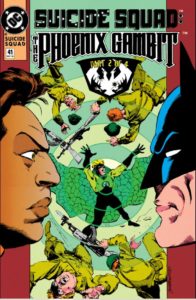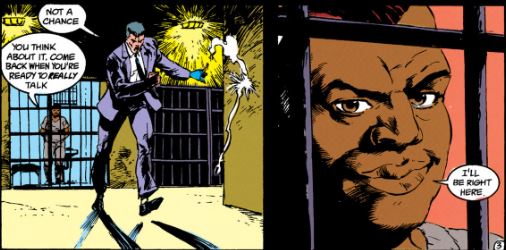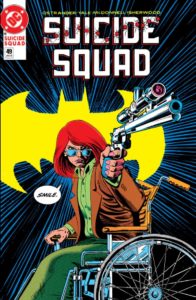
This volume of Suicide Squad collects issues #40-#49. It didn’t hit me right away, but we are about four years into Ostrander’s run. With 18 issues left, the end is just on the horizon. Volume Six functions as a bit of a soft reboot, reformatting the Squad into a freelance, mercenary team for-hire. But everything else I’ve come to love about Suicide Squad remains the same: Concise, tightly-plotted political thrillers with fun character moments. In case you missed it, here is a link to the previous entry.
The Phoenix Gambit
After patiently waiting in a prison cell for a year, Amanda Waller is approached by Sarge Steel with a problem. Taking from current events of the time, the Soviet Union is in disarray under Mikhail Gorbachev. Mysterious “[r]ight-wing elements” have infiltrated the U.S. government and are financing a revolution in Vlatava, a fictitious eastern European country that is under the rule of the Soviet Union. The goal is to push the U.S. into open conflict with Russia at a time when the latter is politically unstable. With no one he can trust in his own department, Steel believes Waller and her Squad provide the best opportunity to quell the violence. Of course, Waller has a few of her own requests to make.
The Phoenix Gambit has a lot of moving pieces for a four-issue story, but it never overstays its welcome. For example, Batman is here but his inclusion feels restrained yet natural. He never overshadows the Squad in their own book, and we get to witness him doing actual detective work. Waller’s release from prison is also handled similarly. Her initial imprisonment was a bleak ending to issue #39, but after a year behind bars, Waller knows exactly what she wants. She becomes a “devil on the shoulder” for Steel and quickly gets what she wants. Turning the Squad into a mercenary team for-hire with complete autonomy is an interesting progression. Unfortunately, it seems as if Belle Reve will not be featured as prominently anymore.

But the real meat of this story arc is the mission to Vlatava. The Squad isn’t new to political intrigue and espionage. However, The Phoenix Gambit kicks it up a notch with what is the series’ most intricate plot. Everyone is a pawn being used by someone else, and it fits the political climate of the Soviet Union at the time. But it’s the “little guy” who suffers the most harm from the political in-fighting. Count Vertigo leads a group of revolutionaries and protestors, some of whom are gunned down by their own government. Even Vertigo himself is simply just a puppet being manipulated by outside forces. But it ends on a rather hopeful yet cautious outlook from both Batman and Amanda Waller. Things are changing and, for better or worse, the Suicide Squad is needed now more than ever.
The Origin of Captain Boomerang
George “Digger” Harkness, a.k.a. Captain Boomerang, takes center stage in this single-issue story set in his home town. Following the death of his beloved mother, Boomerang, along with Deadshot for moral support, heads back to Kurrumburra, Australia, for the funeral. But as you might have suspected, Boomerang is the black sheep in his family. Going home may be his toughest mission yet.
Boomerang is a staple of the Squad, but he’s mostly been relegated to comic relief. He’s an asshole who thinks he’s more clever than he really is, and that has been his schtick more than any trick boomerang ever was. And speaking of boomerangs, Ostrander and guest co-writer David M. DeVries do an excellent job of tying the toy to Captain Boomerang’s origin. Child-sized George Harkness playing catch by himself with his own boomerang is a great way to build sympathy for the Squad’s biggest jerk. His father and older brother could care less for him and his small town has no other kids to play with. But even more surprising is that he eventually finds a lifelong friend. Growing up, the two of them would commit petty crimes. It’s here where we begin to understand why Boomerang turned out the way he did.
But the highlight of this issue is Boomerang’s first battle with the Flash. How he defeats the Scarlet Speedster is more silly than it is unrealistic, but it works because the issue makes you care for Digger first. Captain Boomerang is the protagonist here, not the Flash, so he’s allowed at least one win. But make no mistake, Boomerang is still presented as a bit of a joke. He even casually admits that this is the only time he’s beaten the Flash. But nonetheless, it’s his first accomplishment and the first time people are in awe of him, and it only happens when he wears the tackiest costume ever.
The Jerusalem Serpent
Issues #45-#47 see the return of Kobra, who has ditched the Naga-Naga snake costume. He’s also ditched the brain-melting gun from space in favor of something more palpable: The initiation of a holy war to end all wars. Planning to get imprisoned in Israel, Kobra aims to convince their government’s A.I. system, Dybbuk, into practicing his own self-will by choosing to raze The Dome of the Rock, a Muslim shrine built on top of the ruins of Solomon’s Temple. This, in turn, would start a holy war large enough to bring about the Kali Yuga, also known as the Age of Chaos.
Without his silly snake costume, Kobra is a much more intimidating presence here than in previous appearances. He carries an almost respectful, zen-like calm captured by inker-turned-penciller, Geof Isherwood. But Kobra is matched by another meditative sociopath in Ravan, a character who got lost in the shuffle during The Janus Directive crossover. There is a stronger focus on both characters’ opposing dichotomies this time around: One wishes to bring about the Age of Chaos, the other wants to delay it. Now, they meet face to face. Their battle is brief, merciless, and suitably intense for two zealots fighting for what they believe in.

However, the philosophical showdown between Ramban and Dybbuk is the true highlight of The Jerusalem Serpent. An A.I. gaining sentience and going rogue is the plot of many sci-fi stories, but the twist is executed well here. Weaponizing Dybbuk’s newfound introspection to the point where he questions everything and accomplishes nothing is a novel way of resolving the conflict.
Oracle’s Reckoning
There is a lot of debate over Barbara Gordon’s treatment in Alan Moore’s The Killing Joke. Is it an example of Women in Refrigerators? Is it excessive? Is it necessary? Yale and Ostrander don’t provide answers. Instead, they focus on the very real trauma that comes from being the victim of such an attack and the strength it takes to move on.
By now, it’s no secret to readers that Barbara Gordon is Oracle. But what we do learn is that Oracle is helping other organizations beyond the Suicide Squad. Working with The Institute of Metahuman Studies (IMHS), Oracle attracts the attention of Cliff Carmichael, a sociopath who has upgraded the original Thinker’s Thinking Cap. Now, Barbara must contend with yet another Joker-like predator targeting her.
Barbara’s moral dilemma over whether she should kill Carmichael or not isn’t a new idea for the Bat family, but it’s intensely personal to her in these two issues. Batman doesn’t kill out of fear of becoming no better than his enemies. Barbara doesn’t kill because she wants to avoid succumbing to her fear, anxiety, and anger, all of which stem from one traumatic event. There’s significant panel time given to show just how different her life has become since becoming a paraplegic. But it’s necessary and sets Barbara Gordon apart from the rest of the Bat family, something she struggled with as Batgirl. 
Amanda Waller also gets some key moments as well. Her reunion with Simon LaGrieve, now head of IMHS, is incredibly wholesome, considering their previous fallout. Both are apologetic it happened, and Simon even finds common ground with Waller after becoming the head of IMHS. But more importantly, we learn that Waller still has a conscience. Writers tend to peg Amanda Waller as a cold-blooded antagonist, but her cold practicality is just one aspect of the character. She still has friends, family, and even develops amicable relationships with Squad members. It’s a far cry from the Amanda Waller who doesn’t hesitate to gun down her own people in 2016’s Suicide Squad film.
Getting closer to the end of Ostrander’s run, we’re beginning to see some callbacks to earlier issues. In The Phoenix Gambit, we’re reintroduced to William Heller from Suicide Squad #4. The Thinking Cap from The Doom Patrol/Suicide Squad Special #1 also makes its second appearance. Minor background characters like Zastrow and Stalnoivolk are featured prominently in this volume, as well. Next issue sees the return of General Jeb Stuart as the Squad rescues Rick Flag’s only son. Will the team honor the memory of Rick Flag or will the mission collapse in a rage of fire?




